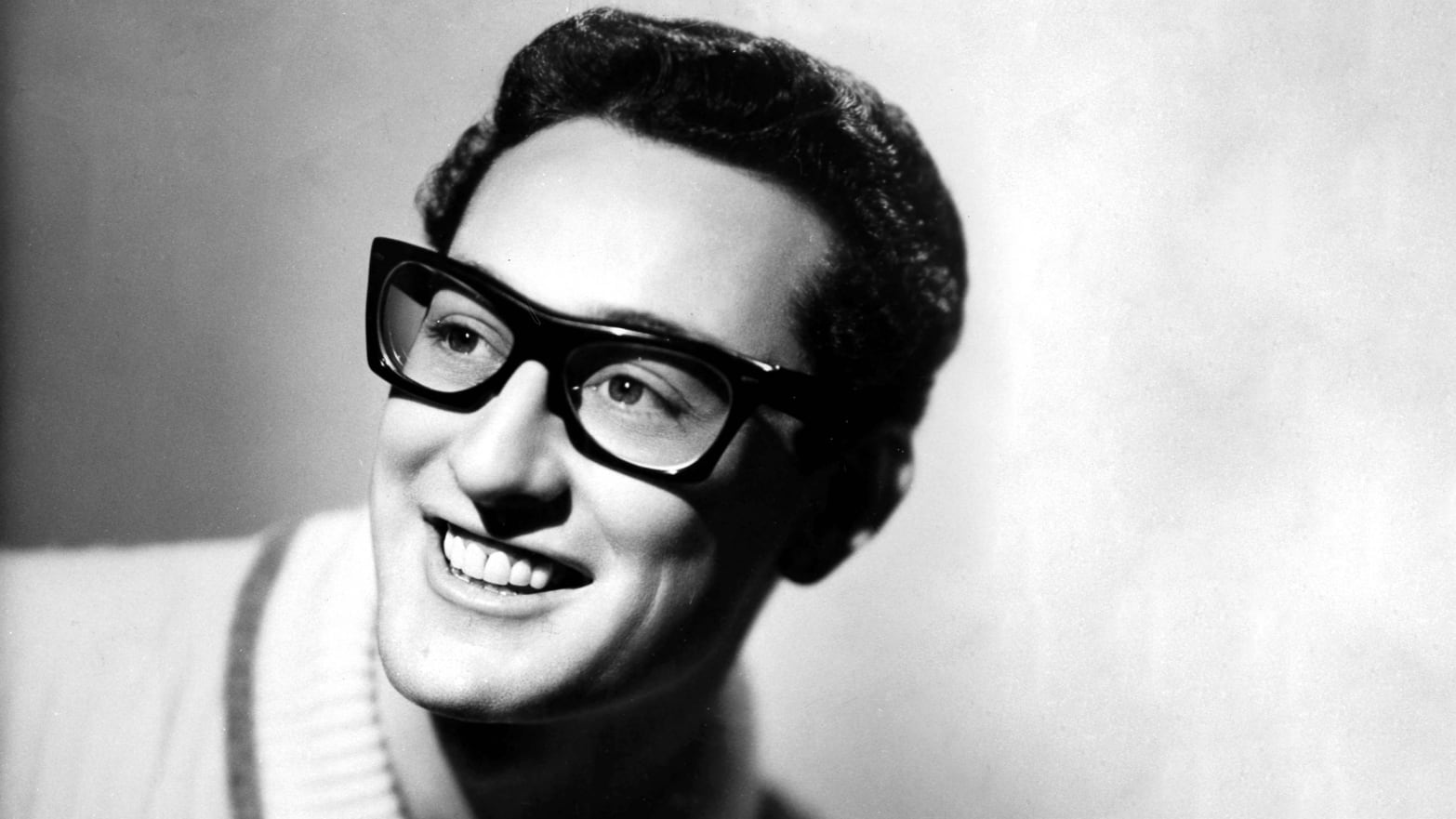Buddy Holly perished 60 years ago, on February 3 in an Iowa cornfield, along with the Big Bopper and Ritchie Valens—the so-called “day the music died,” immortalized in Don McLean’s weepy, chorus-upon-never-ending-chorus number “American Pie.” They were on tour, worn down by the cold and the grind of the tour bus, and opted for an aerial shortcut to the next gig, with a pilot who hadn’t received his license to fly solely by instruments, in the dead of winter.
This tragic demise can dominate Holly’s story, shifting our focus from how radical a musician the man, who only made it to 22, was. He wore horn-rimmed glass, which made him, from a certain point of view, look slightly milksoppish—but in an earnest, quick-with-a-smile way. This was not someone you’d expect to be a rock and roll kicker of asses, especially at a time when rock-and-roll badassery wasn’t just in vogue, but represented by some seriously tough (or tough-looking) cats—Elvis, Gene Vincent, Jerry Lee Lewis.
But it was Holly who strapped on the Fender Stratocaster, the big-boy weaponry. This made Buddy Holly loud. The loudest. He could pick it, too, and Buddy Holly’s right hand was among the strongest in rock history. His band the Crickets followed in attitude, teaming with Holly to formulate the classic line-up of lead guitar, rhythm guitar, bass, and drums, which the Beatles correctly recognized as the right way for them to go, insect name and all.
What does a person achieve in this world as an artist by the age of 22? How possible is it to show more than a flash of the ability you were born with? Part of the miracle that was Buddy Holly was how fully formed he was by this age—which isn’t to say that if you’re fully formed, you won’t be able to extend your growth, producing oohs and aahhs with your latest direction, your latest invention. Buddy Holly was a kicker of ass in terms of physicality, for his music felt like something that was launching itself bodily at you, but he could also kick your ass mentally, making listeners reconsider how far one might push rock’s geographical boundaries, until any conception of them vanished.
The first Buddy Holly song I remember hearing was “It’s So Easy.” The guitar riff is lissome but sinewy, like a piece of wire that threads through the song, with the lyrics, via Holly’s vocal panache, akin to program music for how, exactly, love works. Accept what I say and don’t be a sucker! the singer seems to attest. And I totally accepted this. That combo of the melody and the beat owned me, and while I didn’t put it this way at the time, I realized later on that this was melody in its absolutely purest form, atop which nothing could be added, and from which nothing could be taken. And Buddy Holly had taken me.
“Not Fade Away,” one of his biggest hits, showed that he could venture into Bo Diddley territory and own a portion of it, this thin little white dude from Texas. He had rhythm and blues gusto. Elvis had rhythm and blues attitude and the voice for it, but Holly understood the bedrock of the genre better. He was the master geologist who knew exactly how the layers of the land were stacked, how to drill to its core.
He could out-blues you, out-rhythm you, out-rock you, but he also could out-think you. He double-tracked his vocals, played with overdubs, used fade-ins, utilized vari-speed. He was Brian Wilson and John Lennon and Paul McCartney as a studio wizard—Rock Wizard #1, if we are to assign Les Paul to jazzier fields—and no one began to catch up until the Beatles in ’66, following his example in using the studio as an instrument. There is a lot of Buddy Holly in Revolver.
Holly signed up for acting classes, believing that a better understanding of the thespian’s art would help his development as a musician. He was all-in. His was an age where you found something you did reasonably well, and you did it to death.
At the Holley family home (Buddy dropped the “e”) in late 1956, he retreated to his parents’ garage, all but inventing garage music right then and there, plugging in and letting it crank. What a noise came from the Holley family residence that Christmas season, as Buddy and his mates blasted away, pummel pummel pummel.
The cover of “Good Rockin’ Tonight” sucks some of the swing out of the Elvis version and gives it more drive, more of a forward lean. The blast through Little Richard’s “Rip It Up” is a salvo-canticle for voice and drums at the Church of Rock. No one has ever sung like Buddy Holly. Rock singers can be like classical musicians in that they stick to what they’re supposed to stick to. Sure, they can add descants, mixes in their whoops and an “All right!” and “one more time!” and all that, but they’re not going off-script like a jazz singer will. The latter extemporize, and the script is composed as it is made.
Holly was something different, and you can hear it even at this early practice session. His vocals were always performative. He’d bounce around the script, adding those unique hiccups of his where he felt the thought and emotion warranted them. His voice thought fast, you might say, like Charlie Parker’s lungs thought fast. This was one smart fucking guy. An all-time favorite pronunciation for me—up there with Paul McCartney’s “fauh!” at the start of “I Saw Her Standing There”—is what Holly does with the word “tenderly” in “Listen to Me.” And then there is the rat-a-tat syllabic attack of the five “well’s” that kick off “Rave On,” which makes us commence to raving before the first verse has even started.
Smart in the head is one thing, smart in the heart is another. With an artist possessed of both, it’s game over for all challengers, which is why, if there are 10 performers in rock history that matter more than all others, Buddy Holly is one of them. There is an intriguing history of rock musicians in hotels and apartments. It makes sense, as they spend a lot of time in them and creativity is gonna come when creativity is gonna come. The Beatles wrote “Can’t Buy Me Love” in a hotel, and acts from the Libertines to Dylan recorded notable music in sleeping quarters (ditto Janis Joplin with her Typewriter Tape). But the ultimate grail is Holly’s tape that he made just prior to his death, sitting up late at night in his Greenwich Village apartment, his pregnant wife Maria asleep in the bedroom. It’s a man, his guitar, and an Ampex tape machine.
This is a very different Buddy Holly than the Holly of the garage from two years prior. His enunciation is emphatic, as if he were a film director who’d recorded an intense emotional scene by overcranking the camera, playing it back so that it ran slower. You really hear it on the four versions of “Slippin’ and Slidin,” like Holly is decoding rock and roll for you.
“Peggy Sue Got Married” bookends the original Peggy Sue saga in such a way that you wonder about presentiments. It’s like Buddy is taking care of us, letting us know how the story works out, in this spare moment he has, in case there are not enough in the future. Ah, but you get to thinking things late at night, don’t you, when no one else is up? But at other times you hear Maria stacking plates in the kitchen, the ambient sounds of domesticity adding their human notes to these most human of artistic outpourings.
In 1958, his final full year, Holly released a single which began with the words, “Well all right so I’m being foolish.” This has always floored me. There is flamenco chording as Holly pulls himself open. No one had the balls to stand there and sound like this. Which is one reason why he was the artist he was.
Dylan got to the level of “Well All Right” by his second album, with a song like “Don’t Think Twice, It’s All Right,” which I’ve always heard as a nod to the Buddy Holly song. Lennon would get there with “Help!” and “In My Life” in 1965. “Our lifetime of love will be all right,” Holly sings. There are no hiccupped vocals, and there is no need for them. The hiccups are in our own hearts as we listen, the skipped beats that convey to us that we are not on the way out, but surging towards the irreducible. The Buddy Holly stuff, you might say.

